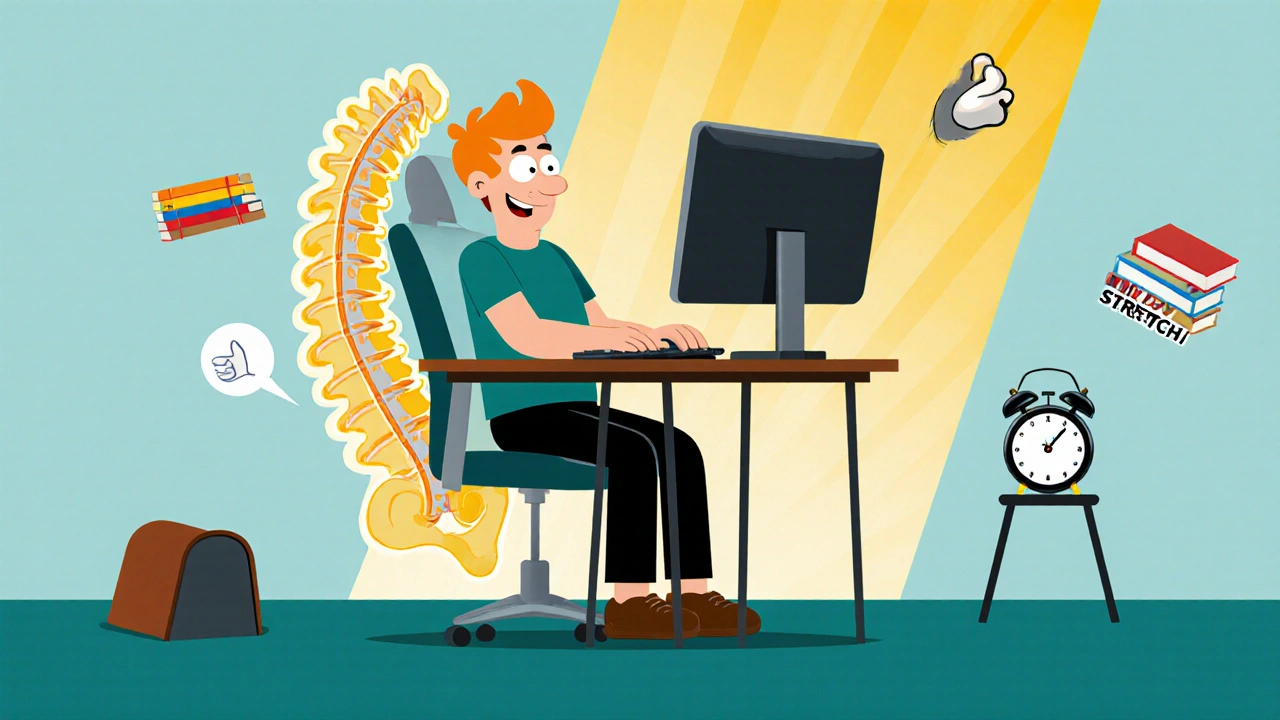Why Your Workstation Is Killing Your Joints
You sit down at your desk. You type. You click. You lean. And by mid-afternoon, your neck aches, your wrists feel stiff, and your lower back screams for mercy. This isn’t just "being tired." It’s your joints paying the price for years of bad posture and a poorly designed workspace. Around 62% of office workers deal with work-related joint pain, and most of it comes from something you can fix today - your chair, your monitor, and how you sit.
It’s not about buying the most expensive chair. It’s about alignment. Your body wasn’t made to hunch over a keyboard for eight hours straight. Your shoulders, wrists, and spine have natural angles. When your workstation fights those angles, your joints suffer. The good news? Fixing this doesn’t require a complete office overhaul. Small, smart changes can cut your pain by up to 40% in just a few weeks.
The 4 Critical Parts of an Ergonomic Workstation
There are four pieces of your setup that matter most: your chair, your monitor, your keyboard, and your mouse. Get these right, and you take pressure off your neck, shoulders, wrists, and lower back.
1. Your Chair: Support, Not Just Cushion
A good chair doesn’t feel soft. It feels stable. Your hips should be slightly higher than your knees, with feet flat on the floor. If your feet dangle, use a footrest. Your thighs should be parallel to the ground - not sloping up or down.
Lumbar support isn’t optional. It needs to fit the natural curve of your lower back, right at the L3-L4 vertebrae. Most cheap chairs have fixed, flimsy lumbar pads that don’t adjust. Look for one with at least 2-4 inches of vertical adjustment. A 2022 study found that chairs under $200 reduced pain by only 12%. Chairs over $400 with proper lumbar control cut pain by nearly 38%.
Seat depth matters too. There should be 1-2 inches between the edge of the seat and the back of your knees. Too deep? You’re putting pressure on your thighs. Too shallow? You’re sliding forward.
2. Your Monitor: Eye Level Is Not What You Think
"Keep your monitor at eye level" is terrible advice. Your eyes naturally look down about 15-20 degrees when relaxed. If you raise your monitor so the top is exactly at eye level, you’re craning your neck up - and that strains your cervical spine. The Mayo Clinic found that a monitor placed more than 30 degrees above eye level increases spinal load by 4.5 times.
Here’s the fix: Position the top of your screen at or just below eye level. Sit back 20-30 inches. Use the fist test: hold a fist between your eyes and the top of the screen. If it fits, you’re good. If you’re using a laptop, you’re probably looking down too far. Get a laptop stand and an external keyboard. It’s cheap. It’s simple. It’s life-changing.
3. Your Keyboard: Keep Your Wrists Neutral
Typing with your wrists bent up or down is like holding a door open all day - eventually, something breaks. Carpal tunnel isn’t caused by typing too fast. It’s caused by typing with your wrists in the wrong position.
Your elbows should rest at 90-110 degrees. Your forearms should be parallel to the floor. Your wrists should stay straight - no bending up, down, or sideways. A keyboard with a negative tilt (slightly angled away from you) helps. Standard flat keyboards force your wrists into 30-45 degrees of extension. Negative tilt trays reduce that to 12 degrees or less, cutting carpal tunnel risk by 43%.
If your desk is too high, your shoulders will hike up. If it’s too low, you’ll lean forward. Adjust your chair or desk so your elbows are at a comfortable angle. If you can’t adjust your desk, try a keyboard tray that slides under your desk.
4. Your Mouse: Don’t Reach
Your mouse should be right next to your keyboard - within 1-3 inches. Every time you reach for it, you’re pulling your shoulder out of alignment. That’s how rotator cuff pain starts.
Switch to a vertical mouse. It keeps your hand in a handshake position, which reduces wrist strain by 50% compared to traditional mice. Users report immediate relief. But here’s the catch: it takes 2-3 weeks to adapt. Stick with it. Your wrist will thank you.
Move Like You Mean It: The Power of Microbreaks
Even the perfect workstation won’t save you if you sit still for hours. Your joints need movement. Static posture is the silent killer of joint health.
The American Physical Therapy Association recommends a 30-60 second break every 30 minutes. That’s it. Stand up. Stretch your arms overhead. Roll your shoulders. Gently tilt your head side to side. Do a quick squat. Walk to the water cooler.
Why? Because static loading on your joints increases pressure on discs and tendons. Microbreaks reduce that pressure by 28%. A 2024 NIOSH update found that timed microbreaks with movement cut joint fatigue by 31% compared to fixed, unstructured pauses.
Set a timer. Use an app. Or just stand up every time you finish an email. It doesn’t have to be fancy. It just has to happen.

What Not to Do: Common Mistakes Even Smart People Make
People spend hundreds on ergonomic gear - then set it up wrong. Here are the top three mistakes:
- Putting the monitor too high. 67% of users misjudge this. They think "eye level" means the top of the screen. It doesn’t. It means the center of the screen should be slightly below eye level.
- Using a chair without adjusting the lumbar support. 38% of users never move the lumbar pad. It’s useless if it’s not aligned with your lower back. Find your L3-L4 spot - it’s where your hands naturally rest when you put them on your hips.
- Ignoring the mouse position. You bought a fancy vertical mouse, but you left it on the far right of your desk. That’s worse than using a regular one. Bring it close.
One Reddit user spent $500 on an ergonomic chair, then sat with it tilted backward. Pain didn’t go away. He adjusted the chair to sit upright - pain dropped from 7/10 to 2/10 in a week.
Home Office? You’re at Higher Risk
68% of remote workers use kitchen chairs, sofas, or dining tables as desks. That’s not an ergonomic setup - it’s a joint hazard. Remote workers have a 22% higher rate of neck and shoulder pain than office workers with proper setups.
You don’t need a fancy desk. But you do need:
- A solid surface at elbow height (use a stack of books if you have to)
- A chair that supports your lower back
- A laptop stand or books to raise your screen
- An external keyboard and mouse
Even a $30 laptop stand and a $25 vertical mouse can make a huge difference. The goal isn’t perfection. It’s progress.
What Works: Real Results from Real People
People who stick with ergonomic changes see real results:
- 72% of remote workers using vertical mice reported wrist pain reduction within two weeks.
- 83% of users with arthritis saw joint pain drop within 6-8 weeks of proper setup.
- Companies with full ergonomic programs saw $4.10 returned for every $1 spent in reduced medical claims and lost workdays.
One user on Trustpilot wrote: "I had chronic shoulder pain for 5 years. I bought a Herman Miller Aeron. Adjusted the lumbar support to my spine. Changed my monitor height. Three weeks later, I didn’t need painkillers anymore. I didn’t even know it could be this simple."

When to Ask for Help
If you’ve tried adjusting everything and still have pain, don’t wait. See a physical therapist or certified ergonomist. They can measure your body dimensions - like your popliteal height (the distance from floor to back of your knee) - to fine-tune your chair height. They can also spot subtle posture issues you can’t see yourself.
And if you’re in California or another state with new ergonomic laws, your employer may be required to provide an assessment. Ask. You’re not being difficult. You’re protecting your body.
The Future Is Personalized
AI-powered ergonomic tools are coming. Some desks now have sensors that tell you when you’ve slouched for too long. They’ll soon suggest personalized adjustments based on your height, weight, and movement patterns. By 2027, 75% of big companies will use them.
But right now? You don’t need AI. You need to sit up straight, move often, and make sure your screen isn’t above your eyes. That’s it.
Start Today - Your Joints Won’t Wait
You don’t need to buy new furniture. You don’t need to wait for Monday. Right now, check your monitor height. Adjust your chair. Move your mouse closer. Stand up and stretch.
These small steps add up. In 30 days, you might not notice a difference. But in 90 days? You’ll wonder why you waited so long.
How long does it take to see results from ergonomic changes?
Most people feel less pain within 2-4 weeks. Wrist and neck discomfort often improve faster - sometimes in just a few days. Lower back and shoulder pain may take 6-8 weeks, especially if you’ve had chronic issues. Consistency matters more than perfection. Stick with the setup, even if it feels awkward at first.
Do I need an expensive chair to fix joint pain?
No. A $50 chair with good lumbar support can work better than a $1,000 chair with poor adjustability. What matters is whether the chair supports your lower back at the right height, lets your feet rest flat, and allows your thighs to be parallel to the floor. Look for adjustable lumbar support, seat depth, and height. You can find decent options under $300.
Is standing all day better than sitting?
No. Standing for hours puts pressure on your knees, hips, and lower back. The goal isn’t to stand - it’s to move. Use a sit-stand desk to alternate between sitting and standing every 20-30 minutes. Studies show the best results come from switching positions, not staying in one.
Can ergonomic changes help with arthritis?
Yes. The Arthritis Foundation found that 83% of users with arthritis saw reduced joint pain after improving their workstation setup. Reducing strain on wrists, shoulders, and neck helps prevent flare-ups. Ergonomic tools like vertical mice, negative tilt keyboards, and monitor arms make daily tasks easier and less painful.
What’s the easiest fix for neck pain?
Raise your monitor. Most neck pain comes from looking down too much. Put your screen higher - so the top is at or just below eye level. Use books, a stand, or a monitor arm. You’ll feel relief within a day. Combine it with microbreaks every 30 minutes, and your neck pain will drop significantly.
Should I use a wrist rest while typing?
Only if you’re not typing. Wrist rests should support your palms, not your wrists, and only when you’re taking a break. Resting your wrists on a pad while typing keeps them bent and increases pressure. Let your hands float naturally above the keyboard. Your wrists should be straight - not resting on anything during active typing.






Alexander Rolsen
November 28, 2025 AT 02:09Leah Doyle
November 28, 2025 AT 16:02Alexis Mendoza
November 29, 2025 AT 03:49Michelle N Allen
November 29, 2025 AT 10:33Madison Malone
November 29, 2025 AT 20:44Graham Moyer-Stratton
November 30, 2025 AT 17:01tom charlton
December 1, 2025 AT 13:22Jacob Hepworth-wain
December 1, 2025 AT 19:03Craig Hartel
December 2, 2025 AT 05:40Chris Kahanic
December 4, 2025 AT 00:40Geethu E
December 5, 2025 AT 15:46anant ram
December 7, 2025 AT 09:13